
| Home | S-100 Boards | History | New Boards | Software | Boards For Sale |
| Forum | Other Web Sites | News | Index |
Introduction To Site
Welcome to the S100Computers.com home page. This web site is setup
for people who are interested in vintage S-100 bus based computers. These
computers were the first home computers people used before IBM-PC, Apple
etc. computers existed. These largely forgotten computers have now experienced
a revival of in interest by hobbyists. There were about 20 major (and many
minor) manufactures of these computers (see
here) which made thousands of
these computers. Many were supplied as "kits" which each user assembled.
The common denominator of all these systems was that they were all designed
around a board with an edge connector consisting of 100 connections.
Multiple boards could be plugged into such a "S-100 bus". Different
manufactures offered unique boards, but by-and-large they all worked together
in an S-100 bus system. The S-100 bus was designed initially for 8 bit CPU's.
It became very popular. It later evolved into a bus for 16 bit CPU's and
finally was approved by the IEEE as the IEEE-696 bus.
This site describes many of the computer boards made for those systems. It also describes new S-100 boards being made today for people that would like to learn, experiment, and use the bus for various uses. There is a core group of users that purchase these boards as bare boards and build functional circuits with them themselves. These new boards are listed here.
This site is for users who enjoy building and reading about electronic circuits as a hobby. Its electronic tinkering using the S100 bus as the base for all circuits. Some use Arduino, Raspberry, Propeller etc. circuits, We use S100 bus circuits here. It could have been Multi-bus, Q bus, Omnibus etc., We use the S100 bus because it and its boards are still very prevalent in the community. There are almost endless eBay listings here on eBay -- so one can quickly get going. The S100 bus is quite flexible and can be used for almost any kind of for 8, 16 and indeed 32 bit CPU. We have so far, for CPU boards alone, we have boards for the Z80, 8080, 6502, 8088, 8086, 80286, 80386, 80486, 68000, 68030 and PDP11, Edison, Raspberry Pi and Arduino/Atmega CPUs.
There is also an active Google Groups S100 Computers Forum that has over 1200 members. This forum has a number of very experienced members that can help you get started building or debugging an S100 Bus computer and inventing new circuits.
This site describes many of the computer boards made for those systems. It also describes new S-100 boards being made today for people that would like to learn, experiment, and use the bus for various uses. There is a core group of users that purchase these boards as bare boards and build functional circuits with them themselves. These new boards are listed here.
This site is for users who enjoy building and reading about electronic circuits as a hobby. Its electronic tinkering using the S100 bus as the base for all circuits. Some use Arduino, Raspberry, Propeller etc. circuits, We use S100 bus circuits here. It could have been Multi-bus, Q bus, Omnibus etc., We use the S100 bus because it and its boards are still very prevalent in the community. There are almost endless eBay listings here on eBay -- so one can quickly get going. The S100 bus is quite flexible and can be used for almost any kind of for 8, 16 and indeed 32 bit CPU. We have so far, for CPU boards alone, we have boards for the Z80, 8080, 6502, 8088, 8086, 80286, 80386, 80486, 68000, 68030 and PDP11, Edison, Raspberry Pi and Arduino/Atmega CPUs.
There is also an active Google Groups S100 Computers Forum that has over 1200 members. This forum has a number of very experienced members that can help you get started building or debugging an S100 Bus computer and inventing new circuits.
S-100 Bus Components:-The Bus & Motherboards
The reason the S-100 bus became the
de facto standard for
early computer hobbyists back in the 1970's and
early 80's was that one was not aligned to any one manufacturer. During
that time there was an explosion of information and interest in home computers.
Early companies were very creative in designing boards with unique features.
They all could function together if they were plugged into a S-100 motherboard.
The IMSAI computer probably being the best known example of this. Early
motherboards were nothing more than 100 pin connectors wired in parallel.
The first home computer the Altair, had a bus structure
like
this.
A small motherboard of 4 board slots could be joined to multiples of these
boards to make a bus of up to about 16 board slots. This arrangement
worked fine for a low clock speed 8080 CPU running at 2 MHz. Soon afterwards
another company IMSAI came out with a more noise resistant
data bus with all connectors on one board. This quickly became the de-facto
"S-100 bus computer". While it is easy to look back now at the early
Altair S-100 computer and see how it could have been improved, we should
remember however, that when Ed Roberts
started there was severe price constraints of what the system could cost.
It was this low cost that got the home computer concept going amongst hobbyists
and launched the industry.

However soon people wanted to increase the speed of
the bus. Longer
multiple board slots soon appeared. It was not long until other electronic
engineers got involved and started producing "active terminated" signal
lines. The Godbout 19 slot S-100 bus board was one of the most
popular. This motherboard had pull up and down resistors on each of the
data, address and control lines to reduce signal noise. A schematic
of this arrangement is illustrated
here. Later many commercial and homebrew S-100 systems had at least
16-18 slots in a board cage to which multiple boards from multiple manufactures
were added. This became the standard home computer setup of the late 1970's.
The 100 individual pins of the S-100 bus are describe
here.
S-100 Bus Boards (or cards) as they were often called, fall into 8 major types:-
CPU Boards
S-100 Bus Boards (or cards) as they were often called, fall into 8 major types:-
CPU Boards
The original Altair and IMSAI computers were driven
with Intel 8080 CPU based boards. The figure below shows an early
Altair CPU board. This was a very basic board with only the required
support 7400 type TTL chips to get the CPU signals out on to the S-100
bus. It did have a top row of pins in a Molex connector to bring some
control lines to a front panel "control" board that allowed the operator
to control detailed aspects of the CPU. Things like single stepping
the instructions in memory, inputting data into memory, resetting the
CPU etc. This was the S-100's first CPU board. The thing was primitive.
It did not even have gold plated edge connectors making corrosion a
problem over time . Improvements soon followed. The IMSAI equivalent
CPU also shown below, at least had gold plated edge connectors as did
almost all S-100 boards after that. IMSAI brought out more controls
to the front panel using instead of a single line 8 pin Molex connector
a 16 pin IC
rainbow wire connector. From then on almost all the early S-100 CPU
board manufactures used this arrangement.
Many S-100 CPU boards then started to appear. Almost at the same time people started to recognize the Zilog Z80 8 bit CPU as an alternative to the 8080. This CPU was easier to interface with in hardware. It also had to ability to easily utilize dynamic RAM memory (see below) and in fact had some extra nice CPU op codes (like inputting from a port addressed in the C register while counting down in the B register). However most of the software catered to the lowest common denominator (8080 code) in these early systems. A company called Technical Design Labs (TDL) later called Xitan, was the first really successful Z80 Based CPU S-100 board. They backed this board up with a System Monitor Board (SMB) that along with a memory board allowed you to have a really functional home computer.
With time people started filling up the real estate on the CPU board with extra components. Such as jump on reset circuits to specific memory locations, ROM's, I/O ports, diagnostic LED's, interrupt controllers and when 16 bit data bus and 24 bit addressing appeared modifications to make them IEEE 696 compatible. An excellent example of a board like this is the Ithaca Intersystem's CPU board. This is the CPU board I have used in my homebrew system. The board is completely IEEE 696 compatible allowing one to actually address 1MG of system RAM. It has an on board interrupt controller and onboard ROM.
Memory Boards
As with the above CPU boards the early S-100 memory boards were very basic. All utilized static RAM chips. The figures below show pictures of the original Altair and IMSAI RAM boards. Because the early CPU's ran at a slow 2MHz clock speed they were simple to construct and were consequently quite reliable. The late 1970's was a time of rapid development of RAM chips. 1K, 2K, 4K, and 8K boards proliferated. Soon people started to look seriously at using dynamic RAM memory chips for the S-100 bus. After a few early boards which had compatibility problems they gradually became as reliable as static RAM boards. There were eventually a number of these boards. Probably one of the most successful was the SD Systems ExpandoRam board. This held what seems like an enormous block of memory at that time (16K). This was latter improved upon to the enormously popular 64K dynamic memory board. There were probably more of these boards sold than all other 64K RAM boards put together at the time. A picture of the board is shown in figure 15. Later, 64k boards became common in both static and dynamic forms. Later still 256K memory boards (see below)) started to appear. Static memory came down in price in the early 1980's so many people switched to using static RAM memory boards. The difficulty of refreshing dynamic memory in an 8/16 bit dual CPU system was simply too much trouble. By 1985 it became common to see S-100 systems with over 500K of memory.
I/O Boards
Clearly in all but the simplest applications you are going to have to get data into and out of the computer. From the start of the S-100 bus era a whole proliferation of I/O boards started to appear. Early S-100 boards where simply parallel, or serial (RS232) port boards. Then both started to appear on the same board. Typical later boards had 1, 2 or 3 serial ports along with a few parallel ports. Later more sophisticated boards started to appear. A major milestone in those early days was the TDL "System Monitor Board". This board ,with a CPU board, gave you a complete functional system. It had a ROM monitor to take care of all software I/O and system initialization. It had 3 serial RS232 ports, a parallel port (for a printer) a cassette interface to read and store data on tape as well as 4K of static RAM. It was the first real example of having software redirecting computer I/O via an "IOBYTE" to different ports. A guy named Roger Amidon in 1976 wrote the Zapple Monitor for the ROM which in countless other situations was used and modified as the basic S-100 startup monitor. The board was way ahead of its time.
With time quite elaborate I/O boards started to appear for the bus.
Following the TDL example most combined serial and parallel
ports on the one board. The Z80 and 8080 allows for only 64
IO ports. One issue that soon started to appear was finding a "block"
of ports on the bus for a new board that did not overlap with other
boards. It became quite important to have a flexible and movable
I/O ports addressable setup. Perhaps the most elaborate example
of I/O port flexibility was the Morrow "Multi I/O board".
You addressed one port on the board which then bank selected other
ports on the board in software. Unfortunately the thing was so complicated
that few spent the time figuring the thing out. Nevertheless the
board was extremely powerful.. It had 3 serial ports, one parallel
port, a timer/clock chip and a interrupt controller chip.
The Cromemco TU-ART dual serial and parallel board was an example
of a board that while powerful requited a lot of IO ports. Another
popular board was the Victor Graphic "ByteStreamer". It had
three serial ports and two parallel ports. Even more
specialized appeared over time. For example the Cromemco
analogue board or the Compupro (local) network board.
Video Boards
The other way these computers were configured to talk to you was to use a video display board to display the information and input the data from a serial or (more common) a parallel keyboard driven port. These boards were typically a bit more complex that some of the above early boards because even in the late 70's CRT controller chip like functions had to be implicated with 7400 TTL chips. A popular video S-100 display board was one made by Solid State Music called the VDB-1. The board was memory mapped meaning that when characters were placed in a certain region of the S-100 CPU's 64K memory space they appeared in the video produced by the board. This allowed fast (but primitive) B&W games to be played. A color output equivalent of this board was the Cromemco Dazzler board. It was an amazing implementation of TTL logic on a 2 piece S-100 board system. Indeed it was quite a few years before any other equivalent color video board could match this Cromemco board. Unfortunately these boards were not capable of displaying more than 64 characters per line on the CRT. The real world for text required 80 characters per line and at least 24 lines per CRT display.
A somewhat later but very popular display board matching these parameters was the SD Systems 8024 video board. As shown above. This S-100 board had it's own CRT controller and character generator chip set. It was I/O mapped, meaning that from a software point of view for the S-100 CPU, it communicated over a set of ports as if it was an external CRT terminal. Towards the end of the S-100 bus era quite sophisticated video boards started to appear. A popular one was the Lomas data "Color Magic" board. This board contained an IEEE 969 24 bit addressable memory mapped video that was completely compatible with the IBM-PC CGA video board. It also had an IBM-PC compatible keyboard port and interrupt controller on board.
Floppy Disk Controller Boards
When Shugart brought out the first 5" floppy disk drives and it became commonly available to S-100 users the world of data storage changed forever. IBM and others already had 8" floppy disk drives and they were becoming more prevalent for those that could afford them, but the 5" floppy was much cheaper. What was needed was a S-100 board to read and write to these drives. Two early formats of disk drives emerged. One was a disk controller by Northstar. This controller board consisted of many 7400 type TTL discrete logic chips. It required a "hard sectored" disk, meaning the disk had many holes, one for each track sector. It was reliable, simple and popular for a time. However with the availability of LSI floppy disc controllers such as the 1771 and 1791/1795 by Western Digital all this changed. Very reliable high density floppy discs could be easily read and written to with S-100 boards that utilized these chips. Further the disks were a single index hole soft sectored type allowing a proliferation of many disk formats. An extremely popular and reliable floppy disk controller of this type was the SD Systems Versafloppy II disk controller. The controller worked with both 8" and 5" drives in single and double density formats. However in the end almost every major S-100 manufacturer had their own disk controller.
Other popular floppy disk controller S-100 boards were those by CompuPro and Cromemco. These types of boards represented to some extent the apex of the S-100 board era. They were quite complex for their time and made good use of the boards real estate. They were very reliable.
Hard Disk Controllers
Other popular hard disk controller S-100 boards were those by CompuPro, Morrow and Cromemco.
Front Panel Board
While not strictly essential, a front panel control board makes life much easier when building an S-100 system. Some early systems came with one already built in. The best known being the classical Altair and IMSAI computer system front panels. These boards via the numerous switches allowed the operation to do things like examine a memory location or port, alter the values there, or "single step" the CPU one instruction at a time through memory. Historically the front panel also generated the S-100 memory write signal (pin 68) by combining the status line sOUT and the line pWR*. Later CPU boards of course moved this function to their CPU board. You should always check this however and make sure there are not two memory write signals being generated on the bus. This still remains one of the most embarrassing aspects of the S-100 Bus. There is no reason why the memory write signal should be treated any different to other bus signals generated by the CPU or slave controller. I have spent some time with my own homebrew system putting together a more modern front panel board that is IEEE-696 compatible and controls the bus and displays the program counter etc. in HEX display LED's. This will be described elsewhere on this site. The Wamco front panel shown below was a particularly good board and is described in more detail here.
SPECIAL BOARDS
Over time many specialized S-100 boards appeared. These included modem boards, math processor boards, speech synthesis boards, time clock boards, and many relay control I/O boards. Here are just four.
Towards the early 1980's with the approval of the IEEE 969 standard, S-100 bus boards had become very sophisticated allowing multiple 8 and 16 bit CPU's on the bus and clock speeds of up to 5MHz and above. Today S-100 based computers do not exist commercially. Technology has moved on. CPU clock speeds are now in the GHz range rather that the 2-5 MHz ranges. 32 and 64 bit systems are the standard and computer buses it they exist at all on a home computer systems are orders of magnitude faster and more complex. Nevertheless there is a growing number of amateur computer collectors and hobbyists that collect and maintain S-100 based computers much as veteran car collectors and hobbyists work with cars of the by-gone ages. This web site is one of a number that shares this passion. It is by no means inclusive, it is however the effort of one person to share with others the magic of those early days and reinvent the spirit.
Over the past few years the group has introduced a diverse range of S100 Bus boards. These include CPU boards like the 8086, 80286, 80386, 80486, 68000, 68030, and PDP11.
RAM boards now go up to the 32MB range. Video board go to the XVGA resolution etc. Please see here for a list of the new S100 bus boards.
 |
Many S-100 CPU boards then started to appear. Almost at the same time people started to recognize the Zilog Z80 8 bit CPU as an alternative to the 8080. This CPU was easier to interface with in hardware. It also had to ability to easily utilize dynamic RAM memory (see below) and in fact had some extra nice CPU op codes (like inputting from a port addressed in the C register while counting down in the B register). However most of the software catered to the lowest common denominator (8080 code) in these early systems. A company called Technical Design Labs (TDL) later called Xitan, was the first really successful Z80 Based CPU S-100 board. They backed this board up with a System Monitor Board (SMB) that along with a memory board allowed you to have a really functional home computer.
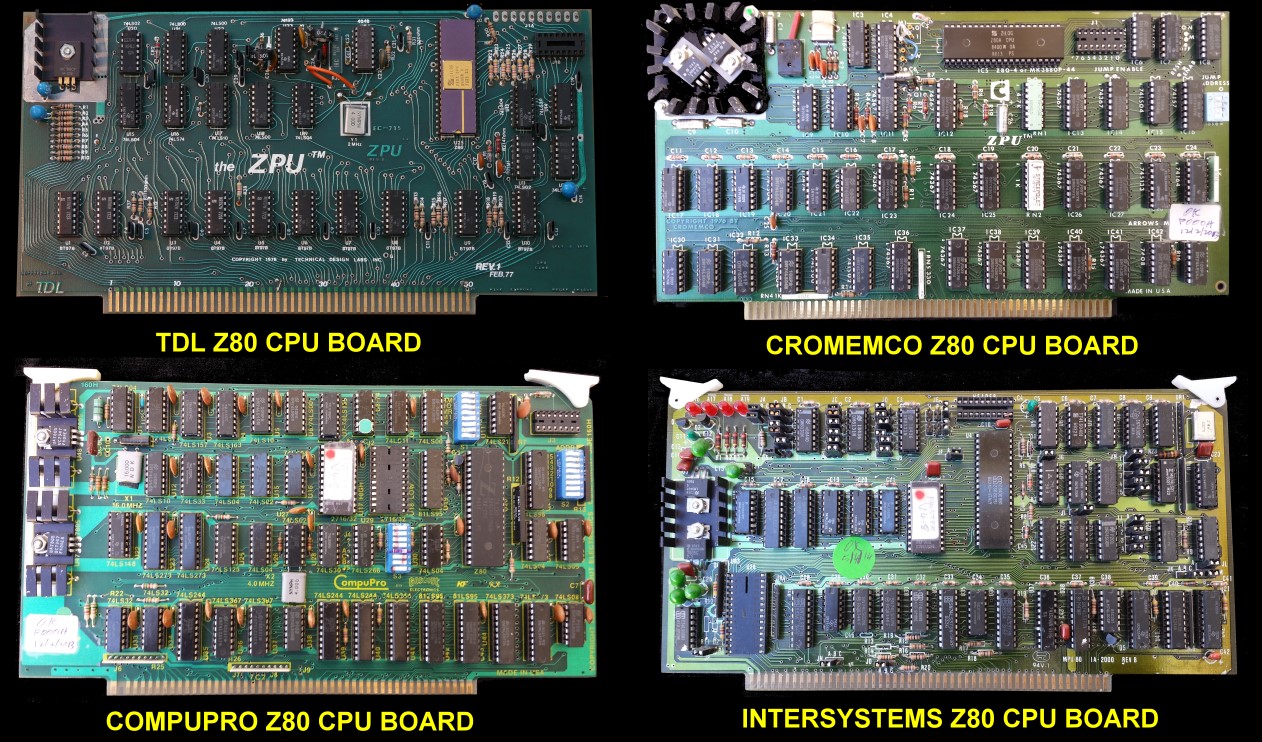 |
With time people started filling up the real estate on the CPU board with extra components. Such as jump on reset circuits to specific memory locations, ROM's, I/O ports, diagnostic LED's, interrupt controllers and when 16 bit data bus and 24 bit addressing appeared modifications to make them IEEE 696 compatible. An excellent example of a board like this is the Ithaca Intersystem's CPU board. This is the CPU board I have used in my homebrew system. The board is completely IEEE 696 compatible allowing one to actually address 1MG of system RAM. It has an on board interrupt controller and onboard ROM.
Memory Boards
As with the above CPU boards the early S-100 memory boards were very basic. All utilized static RAM chips. The figures below show pictures of the original Altair and IMSAI RAM boards. Because the early CPU's ran at a slow 2MHz clock speed they were simple to construct and were consequently quite reliable. The late 1970's was a time of rapid development of RAM chips. 1K, 2K, 4K, and 8K boards proliferated. Soon people started to look seriously at using dynamic RAM memory chips for the S-100 bus. After a few early boards which had compatibility problems they gradually became as reliable as static RAM boards. There were eventually a number of these boards. Probably one of the most successful was the SD Systems ExpandoRam board. This held what seems like an enormous block of memory at that time (16K). This was latter improved upon to the enormously popular 64K dynamic memory board. There were probably more of these boards sold than all other 64K RAM boards put together at the time. A picture of the board is shown in figure 15. Later, 64k boards became common in both static and dynamic forms. Later still 256K memory boards (see below)) started to appear. Static memory came down in price in the early 1980's so many people switched to using static RAM memory boards. The difficulty of refreshing dynamic memory in an 8/16 bit dual CPU system was simply too much trouble. By 1985 it became common to see S-100 systems with over 500K of memory.
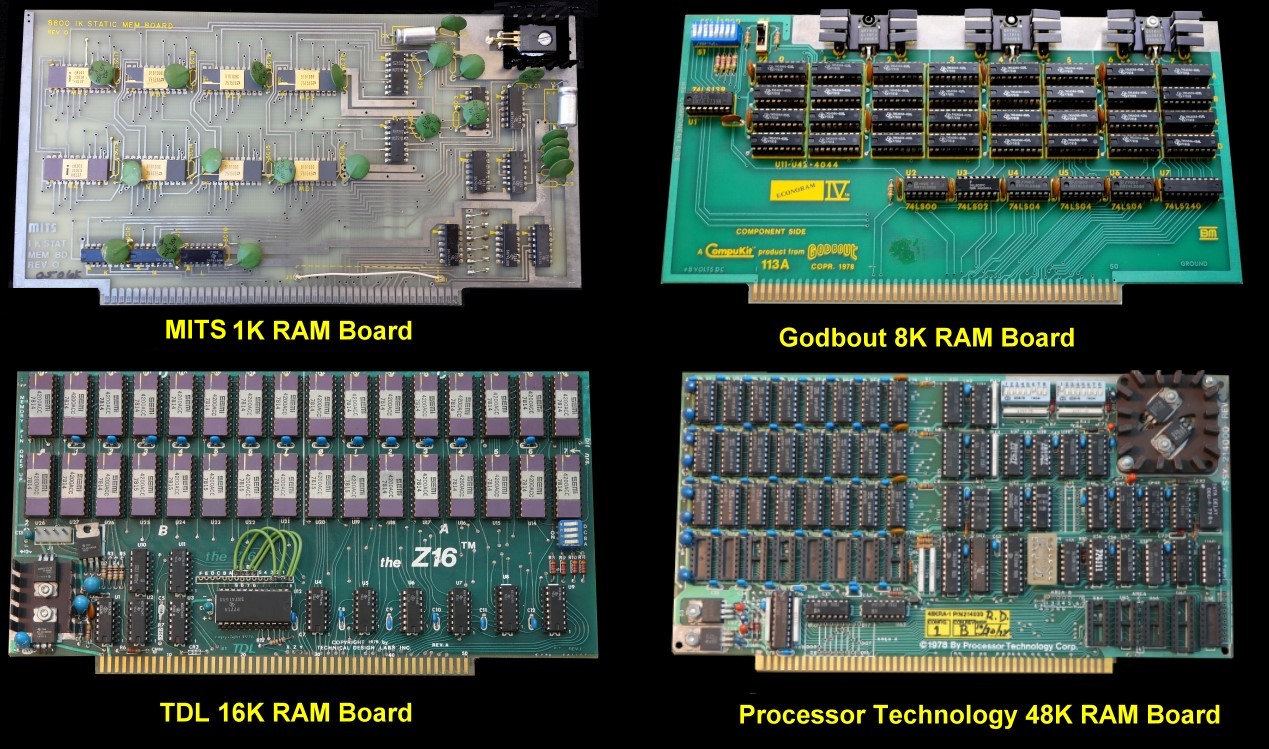 |
|
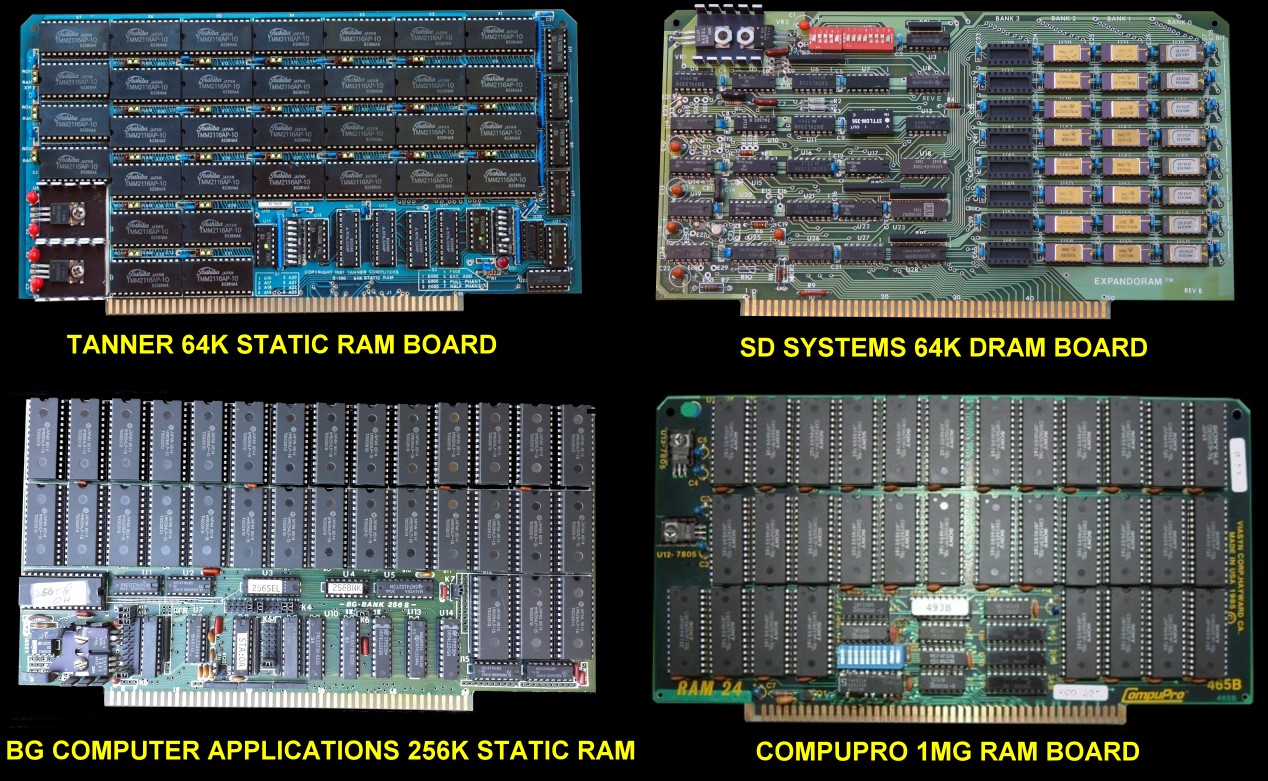 |
I/O Boards
Clearly in all but the simplest applications you are going to have to get data into and out of the computer. From the start of the S-100 bus era a whole proliferation of I/O boards started to appear. Early S-100 boards where simply parallel, or serial (RS232) port boards. Then both started to appear on the same board. Typical later boards had 1, 2 or 3 serial ports along with a few parallel ports. Later more sophisticated boards started to appear. A major milestone in those early days was the TDL "System Monitor Board". This board ,with a CPU board, gave you a complete functional system. It had a ROM monitor to take care of all software I/O and system initialization. It had 3 serial RS232 ports, a parallel port (for a printer) a cassette interface to read and store data on tape as well as 4K of static RAM. It was the first real example of having software redirecting computer I/O via an "IOBYTE" to different ports. A guy named Roger Amidon in 1976 wrote the Zapple Monitor for the ROM which in countless other situations was used and modified as the basic S-100 startup monitor. The board was way ahead of its time.
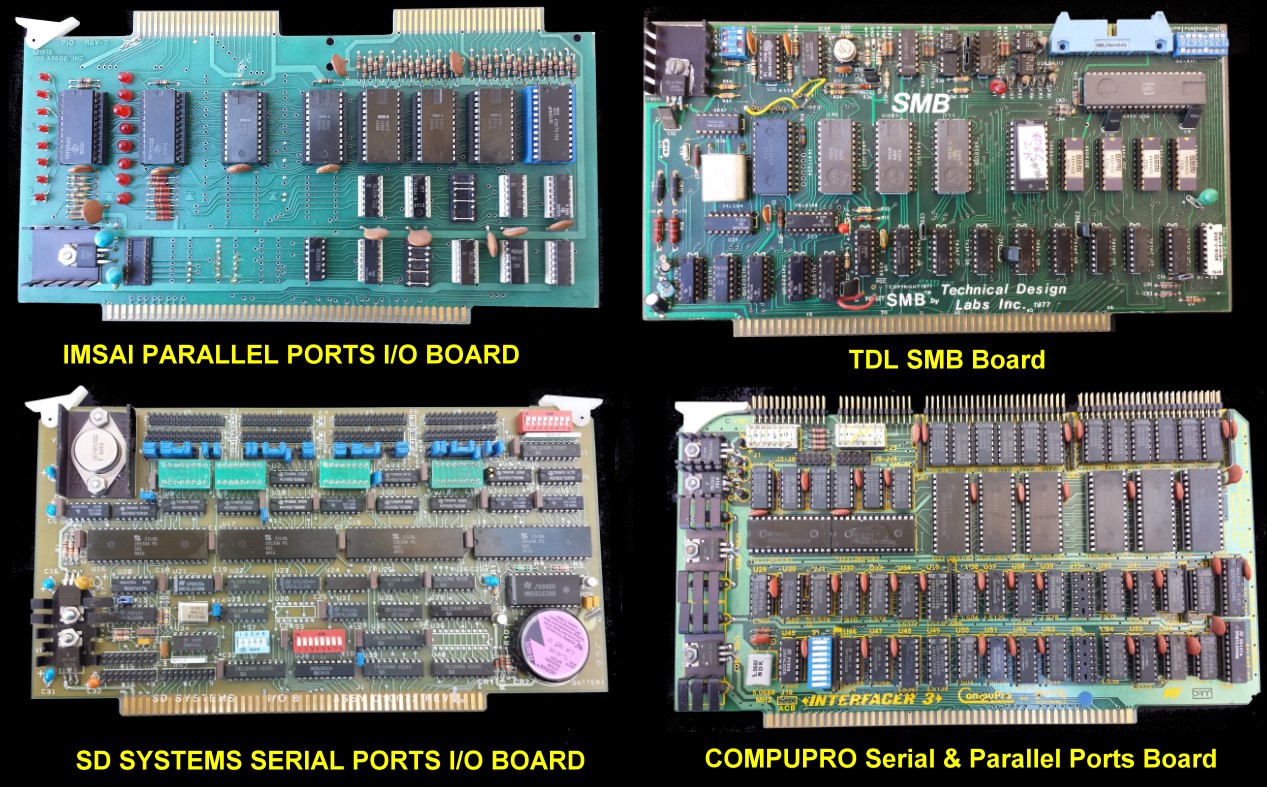 |
 |
Video Boards
The other way these computers were configured to talk to you was to use a video display board to display the information and input the data from a serial or (more common) a parallel keyboard driven port. These boards were typically a bit more complex that some of the above early boards because even in the late 70's CRT controller chip like functions had to be implicated with 7400 TTL chips. A popular video S-100 display board was one made by Solid State Music called the VDB-1. The board was memory mapped meaning that when characters were placed in a certain region of the S-100 CPU's 64K memory space they appeared in the video produced by the board. This allowed fast (but primitive) B&W games to be played. A color output equivalent of this board was the Cromemco Dazzler board. It was an amazing implementation of TTL logic on a 2 piece S-100 board system. Indeed it was quite a few years before any other equivalent color video board could match this Cromemco board. Unfortunately these boards were not capable of displaying more than 64 characters per line on the CRT. The real world for text required 80 characters per line and at least 24 lines per CRT display.
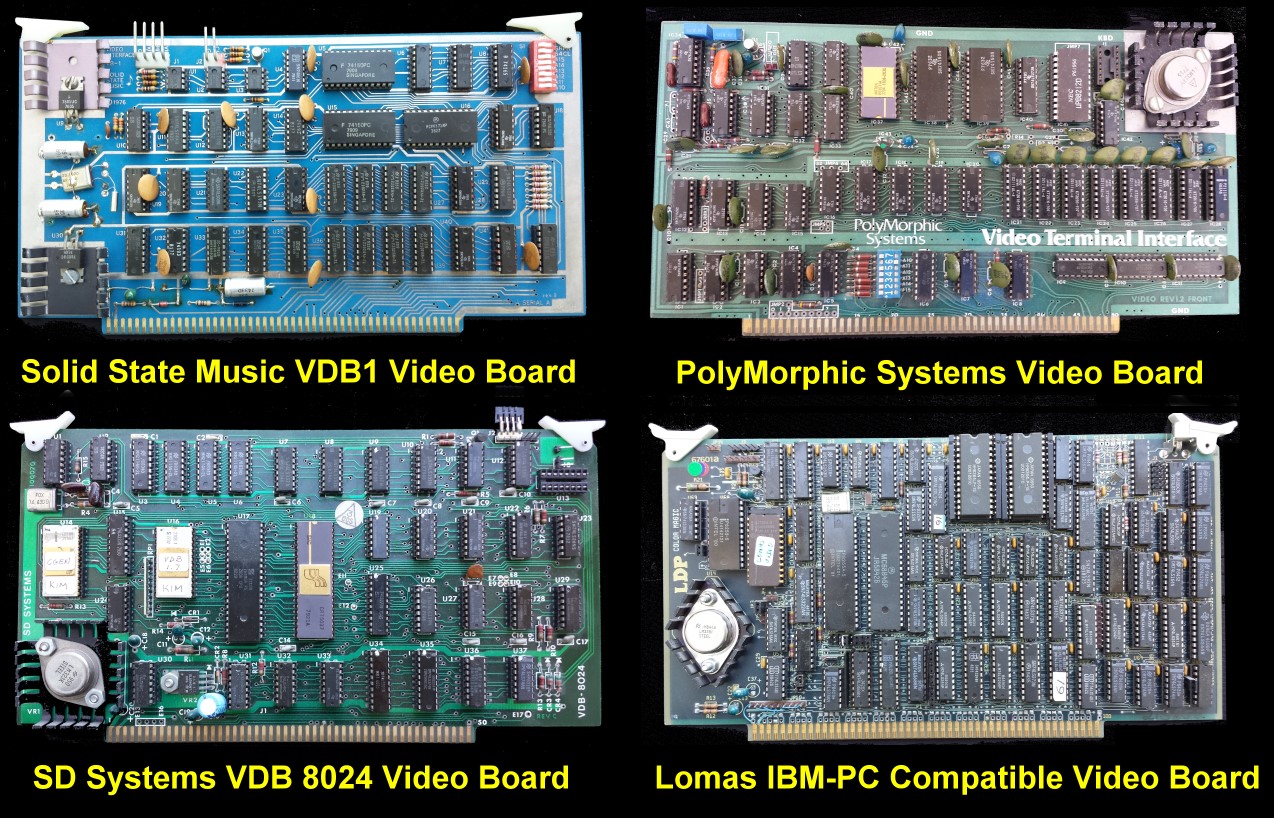 |
A somewhat later but very popular display board matching these parameters was the SD Systems 8024 video board. As shown above. This S-100 board had it's own CRT controller and character generator chip set. It was I/O mapped, meaning that from a software point of view for the S-100 CPU, it communicated over a set of ports as if it was an external CRT terminal. Towards the end of the S-100 bus era quite sophisticated video boards started to appear. A popular one was the Lomas data "Color Magic" board. This board contained an IEEE 969 24 bit addressable memory mapped video that was completely compatible with the IBM-PC CGA video board. It also had an IBM-PC compatible keyboard port and interrupt controller on board.
Cassette Boards
Early S-100 computers loaded and stored data on common cassette
magnetic tapes. The TDL System monitor described above for
example had the hardware to do this. However this system was finicky
and was never real popular. A very popular dedicated S-100 board
for reading and writing to a cassette was one made by Tarbell.
It was almost universal in its acceptance and quite reliable.
These days when I download from the web a 10MG file in seconds I
sometimes reflect on the time and tension one experienced when downloading
a 100K file on a cassette from a friend. Taking many minutes (and
sometimes try's) to do in those days. Other tape controller
boards did exist but none as popular as the Tarbell. For a
brief period of time even commercial software was sold in "Tarbell
format".
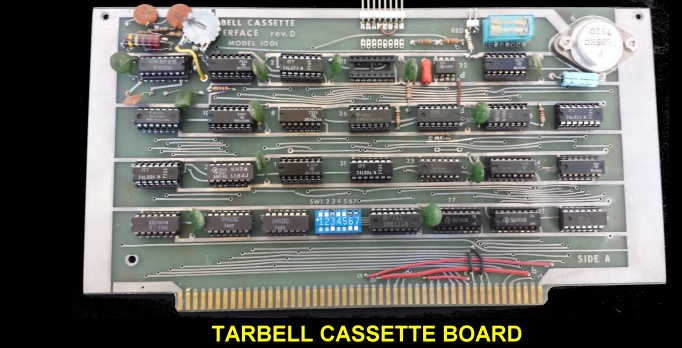 |
Floppy Disk Controller Boards
When Shugart brought out the first 5" floppy disk drives and it became commonly available to S-100 users the world of data storage changed forever. IBM and others already had 8" floppy disk drives and they were becoming more prevalent for those that could afford them, but the 5" floppy was much cheaper. What was needed was a S-100 board to read and write to these drives. Two early formats of disk drives emerged. One was a disk controller by Northstar. This controller board consisted of many 7400 type TTL discrete logic chips. It required a "hard sectored" disk, meaning the disk had many holes, one for each track sector. It was reliable, simple and popular for a time. However with the availability of LSI floppy disc controllers such as the 1771 and 1791/1795 by Western Digital all this changed. Very reliable high density floppy discs could be easily read and written to with S-100 boards that utilized these chips. Further the disks were a single index hole soft sectored type allowing a proliferation of many disk formats. An extremely popular and reliable floppy disk controller of this type was the SD Systems Versafloppy II disk controller. The controller worked with both 8" and 5" drives in single and double density formats. However in the end almost every major S-100 manufacturer had their own disk controller.
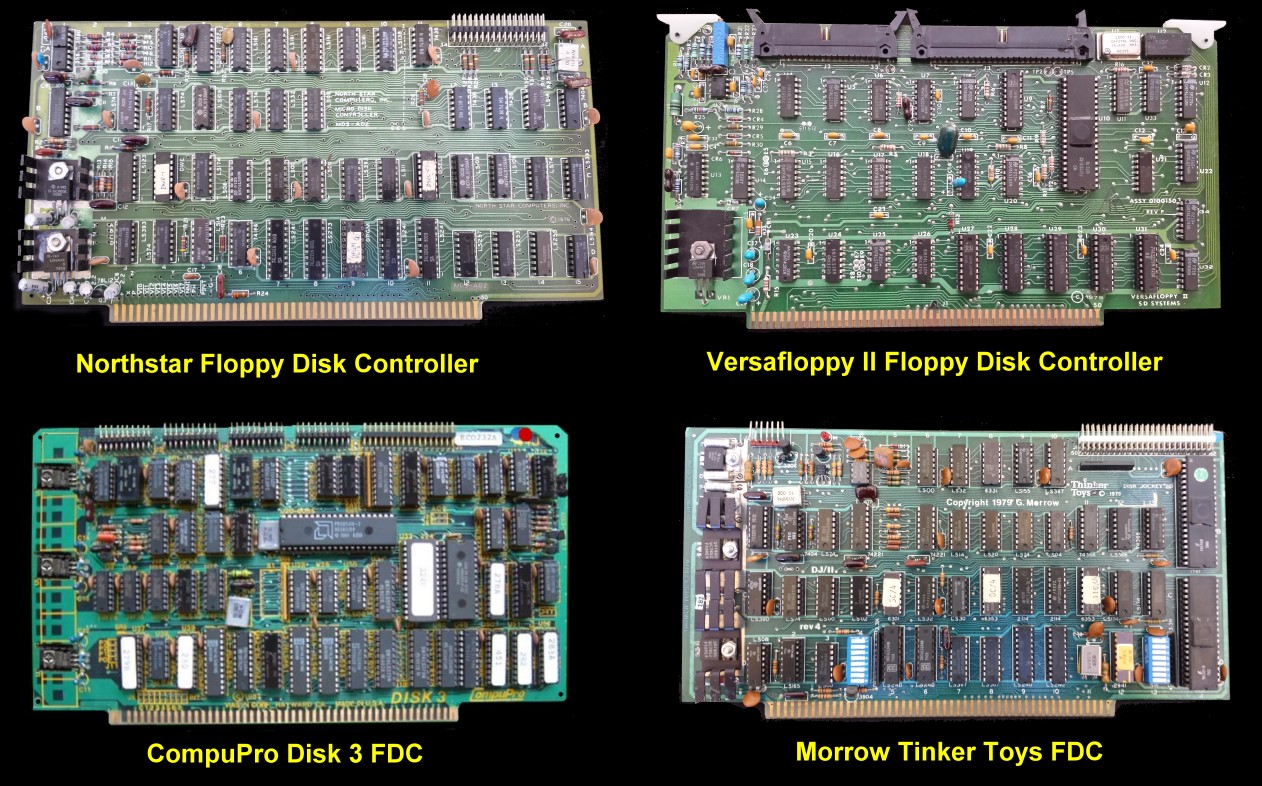 |
Other popular floppy disk controller S-100 boards were those by CompuPro and Cromemco. These types of boards represented to some extent the apex of the S-100 board era. They were quite complex for their time and made good use of the boards real estate. They were very reliable.
Hard Disk Controllers
Next came hard disks as the medium of storing data in S-100 based
computers. I remember well the day I installed my first 5 MG Shugart
hard disk. And how I marveled at all that storage space! S-100
controller boards for hard disks were initially slow in coming.
There was no equivalent of the 1771 or 1791/95 controller chips.
Furthermore these early pre IBM-PC, MFM encoded drives did not have
a disk controller on the drive (as current IDE, SATA etc. drives
have). Everything had to be done in 7400 based TTL logic chips and
software. Eventually however hard disk controller boards came.
One very good and reliable board (actually two S-100 boards joined
via an overhead connector), was the XComp disk controller board.
This board set is shown below. The board could control both 8" or
the soon to become more common 5" drives.
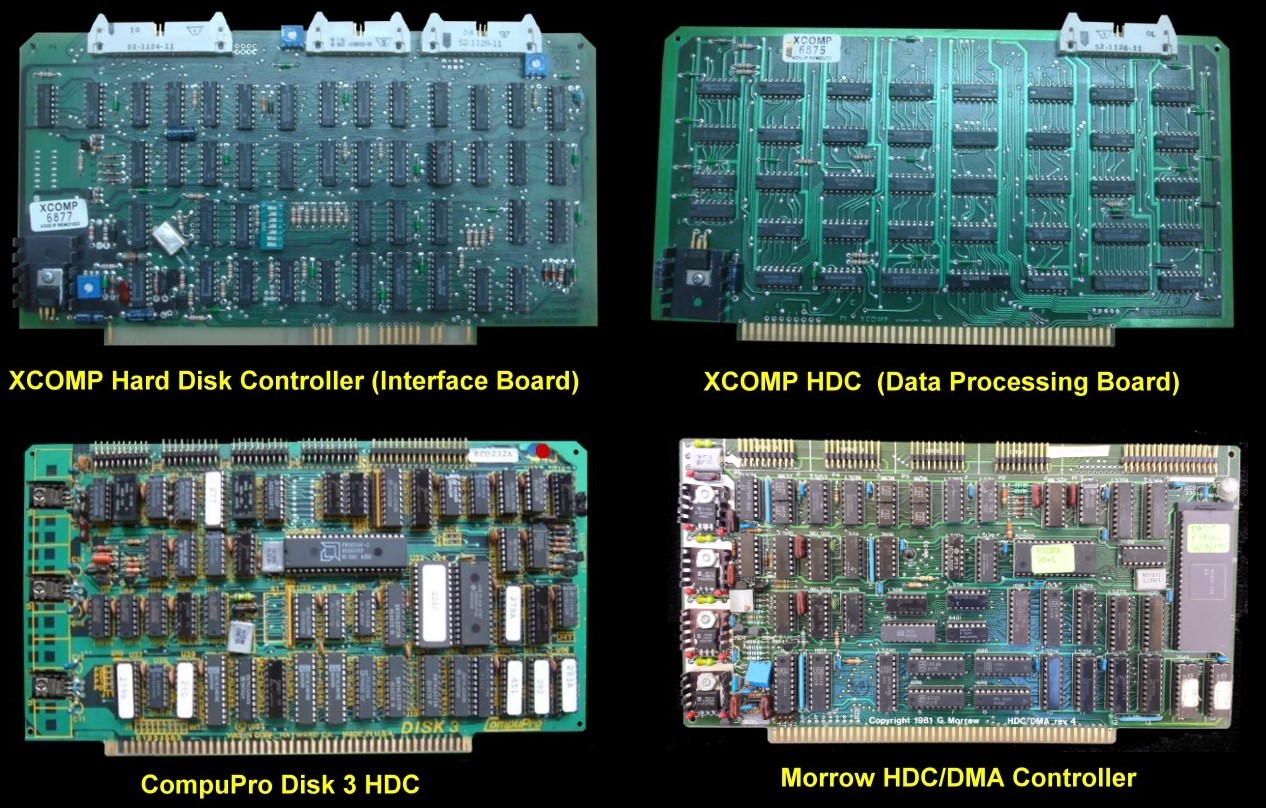 |
Other popular hard disk controller S-100 boards were those by CompuPro, Morrow and Cromemco.
Front Panel Board
While not strictly essential, a front panel control board makes life much easier when building an S-100 system. Some early systems came with one already built in. The best known being the classical Altair and IMSAI computer system front panels. These boards via the numerous switches allowed the operation to do things like examine a memory location or port, alter the values there, or "single step" the CPU one instruction at a time through memory. Historically the front panel also generated the S-100 memory write signal (pin 68) by combining the status line sOUT and the line pWR*. Later CPU boards of course moved this function to their CPU board. You should always check this however and make sure there are not two memory write signals being generated on the bus. This still remains one of the most embarrassing aspects of the S-100 Bus. There is no reason why the memory write signal should be treated any different to other bus signals generated by the CPU or slave controller. I have spent some time with my own homebrew system putting together a more modern front panel board that is IEEE-696 compatible and controls the bus and displays the program counter etc. in HEX display LED's. This will be described elsewhere on this site. The Wamco front panel shown below was a particularly good board and is described in more detail here.
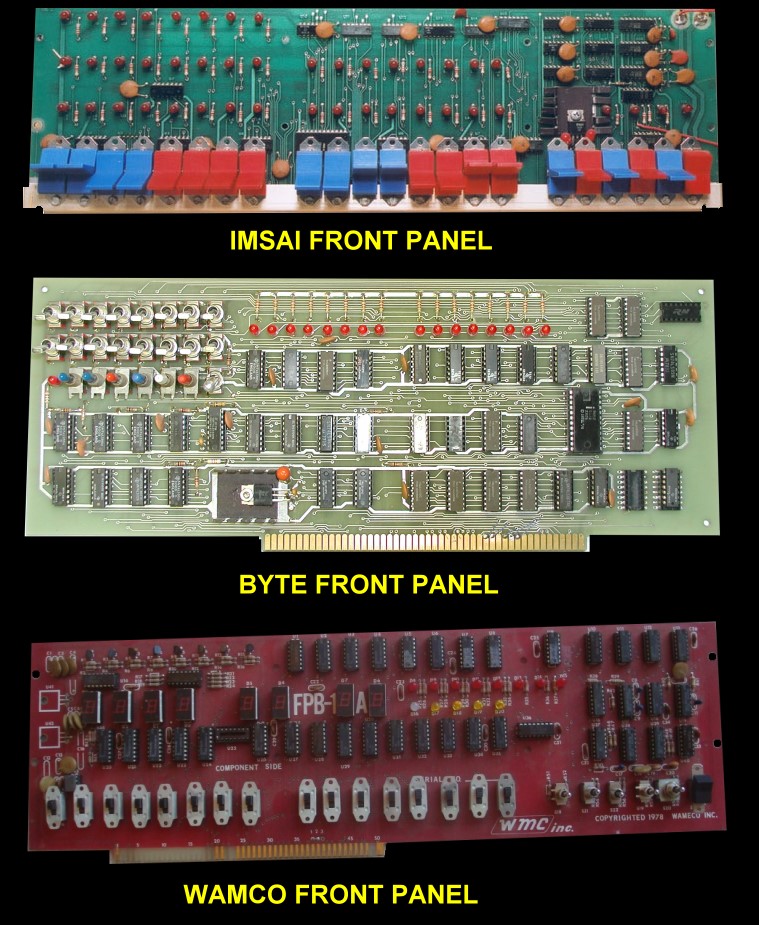 |
SPECIAL BOARDS
Over time many specialized S-100 boards appeared. These included modem boards, math processor boards, speech synthesis boards, time clock boards, and many relay control I/O boards. Here are just four.
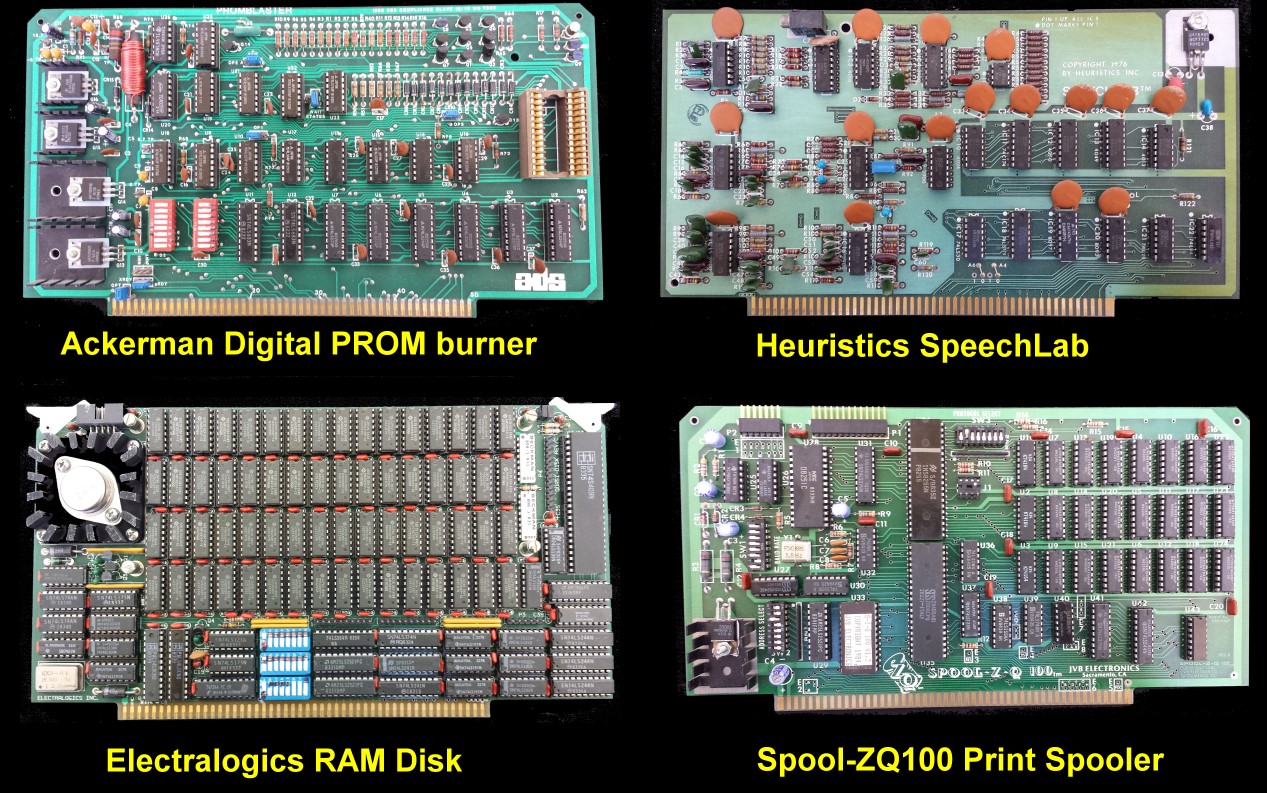 |
Towards the early 1980's with the approval of the IEEE 969 standard, S-100 bus boards had become very sophisticated allowing multiple 8 and 16 bit CPU's on the bus and clock speeds of up to 5MHz and above. Today S-100 based computers do not exist commercially. Technology has moved on. CPU clock speeds are now in the GHz range rather that the 2-5 MHz ranges. 32 and 64 bit systems are the standard and computer buses it they exist at all on a home computer systems are orders of magnitude faster and more complex. Nevertheless there is a growing number of amateur computer collectors and hobbyists that collect and maintain S-100 based computers much as veteran car collectors and hobbyists work with cars of the by-gone ages. This web site is one of a number that shares this passion. It is by no means inclusive, it is however the effort of one person to share with others the magic of those early days and reinvent the spirit.
Over the past few years the group has introduced a diverse range of S100 Bus boards. These include CPU boards like the 8086, 80286, 80386, 80486, 68000, 68030, and PDP11.
RAM boards now go up to the 32MB range. Video board go to the XVGA resolution etc. Please see here for a list of the new S100 bus boards.
Contact Information
There is now a new Google Groups forum to discuss new S100 boards described on this web site.
If you have questions about a board or wish to get on the list for a new board please feel free to join and participate here:-
There is now a new Google Groups forum to discuss new S100 boards described on this web site.
If you have questions about a board or wish to get on the list for a new board please feel free to join and participate here:-
| https://groups.google.com/forum/?fromgroups#!forum/s100computers |
As a last resort you
can reach me (John Monahan, Danville, CA) via e-mail at:-
monahan-vitasoft.org (Substitute the "-" character with an @ character).
monahan-vitasoft.org (Substitute the "-" character with an @ character).
This page was last modified on 05/26/2025